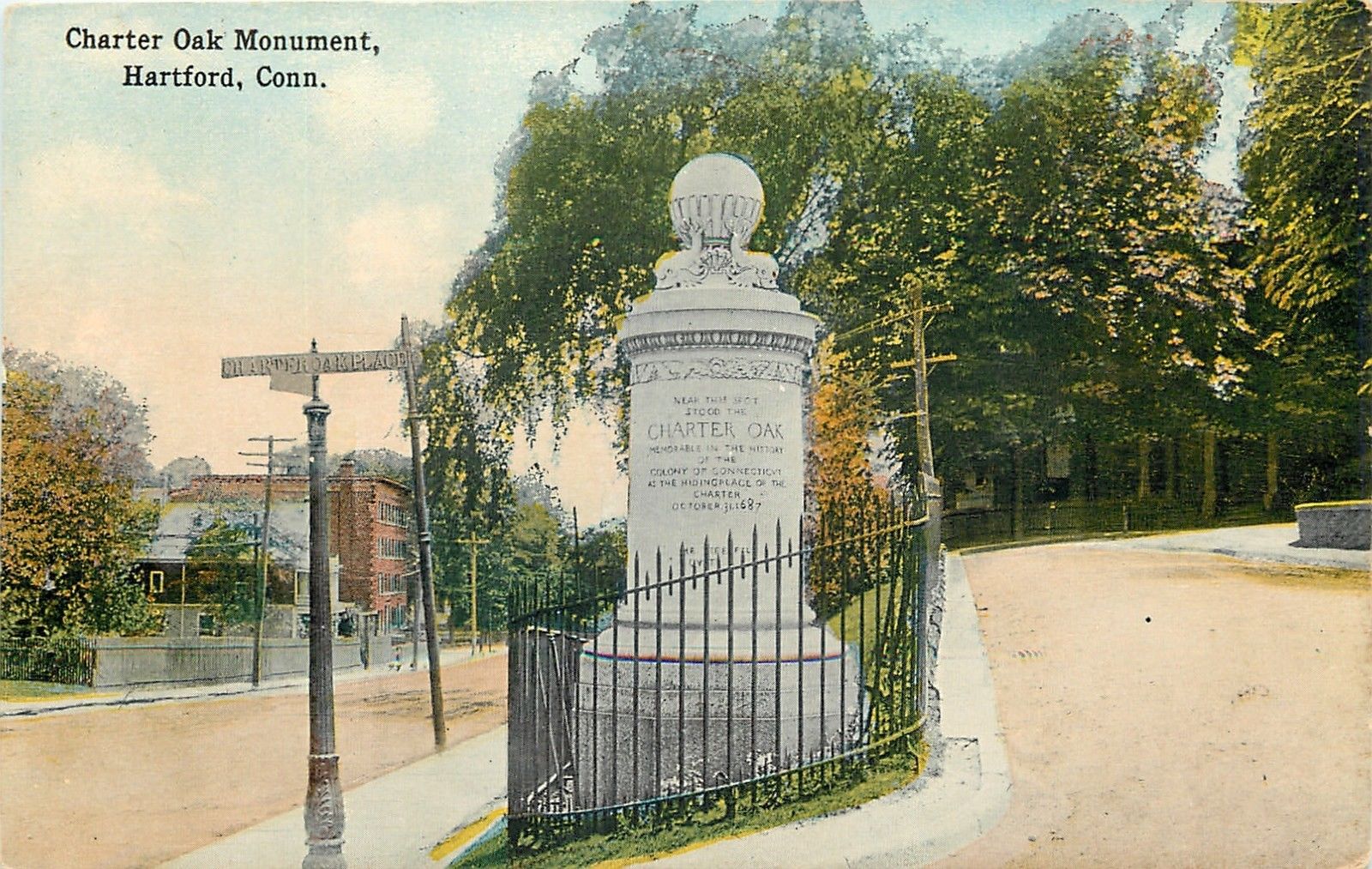Amid Storms of Life: Great Oak on River Bluff, Sowheag, Stories
During a pandemic, under multiple strains and stresses, find your way forward. Savor the season because autumn approaches. Here is a story about an ancient oak revered by two cultures and when it fell to earth–Hartford, Connecticut. A place beside a long tidal river with a name that has indigenous roots.
Chiseled into the base is “Near this spot stood the Charter Oak… The tree fell August 21, 1856.”
Crash, boom – and it was gone. Pieces to pick up. Life goes on.
One page from centuries of life for the oak; so inspired by reading about this tree – which had the reported circumference of 33 feet and was large enough that 27 persons have stood in the hollow where the charter was once stashed – a trip was made to see the modern-day memorial to its fame and life. The stone stub is placed at the intersection of some busy streets. To exit a vehicle and look at the inscription – well, use plenty of caution and park well out of the streaming traffic.
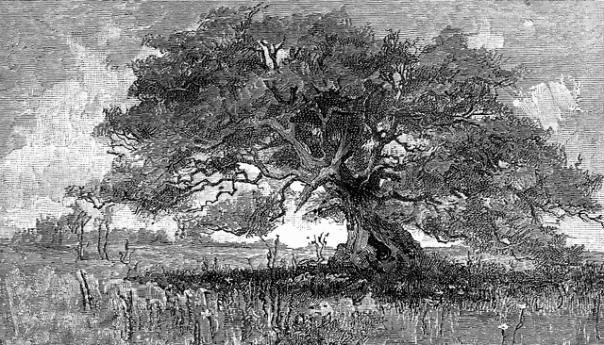
Known as the peace tree long before a charter was hidden inside its hollow.
The great oak tree with a hollow cavity that fell in August 1856 still holds more stories than you can shake a stick at – a few survive from when the massive branches sheltered Native Americans who gathered there. They must have enjoyed an incredible vantage point overlooking what would later become known as the Connecticut River as well as a smaller tributary river flowing nearby.
Here's a tale from Wadsworth or the Great Oak in which a tree branch kills a man – but more interesting is the details of people who knew the old oak as their “peace” tree:
“In the war, my reward being 340 acres in the great swamp and which I afterwards sold to Lieutenant John Ellsworth, who was killed on the place by a tree falling on him.
“After the defeat and death of Nowashe, the Mohawks remained with Saweg's tribe for several days, celebrating their victory and at the same time giving the wounded an opportunity to recover before starting on the march to Onondaga. During this period the sagamores and powwows of the tribe met under the oak and in the presence of the Mohawks removed the dead limb from the peace tree, charring it near the trunk with fire and reducing it to ashes as soon as it fell. This limb, as has been stated, was on the northeast side of the tree and in the years which followed, the rain and the snow, reinforced by the heat and the frost, caused the balance of the branch to decay and make a hole in the side of the oak.
“In those years the sachemship of the tribe descended from Saweg to his son, who was in time succeeded by Sowheag, the father of Sequassen, the leader of the Suckiag Indians when the white man came to the Connecticut valley. Having been defeated by the Pequots, from whom the Dutch traders had purchased a title to a portion of the land occupied by his tribe, he hailed the coming of the Hooker company with delight and sold its members the site of Hartford for a few coats, blankets, knives and hoes. The transfer was made under the old oak on what was afterwards the Wyllys home lot, Elder William Goodwin and my uncle, Samuel Stone, acting for the English, and Sequas-sen, who signed the deed with an acorn totem, acted for the Suckiag tribe, all of his sagamores being present and giving their consent to the transfer.
“After the deed had been signed a twig and a piece of turf were handed Sequassen by one of the sagamores. He stuck the twig in the turf and placed both in Elder Goodwin's hands. By this ceremony he considered himself to have passed over to the English the soil and all that grew on it.
“This was the Indians' last meeting under the tribe's peace tree, and except when they asked William Gibbons to spare it, the old oak did not attract very much attention until after the overthrow of the Andros government.”
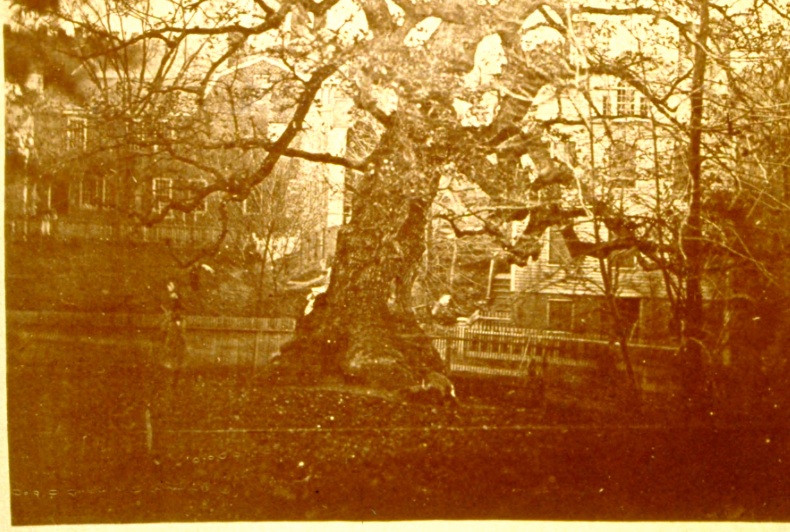
The trunk of the Charter Oak from an actual photograph. The great tree fell to earth on Aug. 21, 1856.
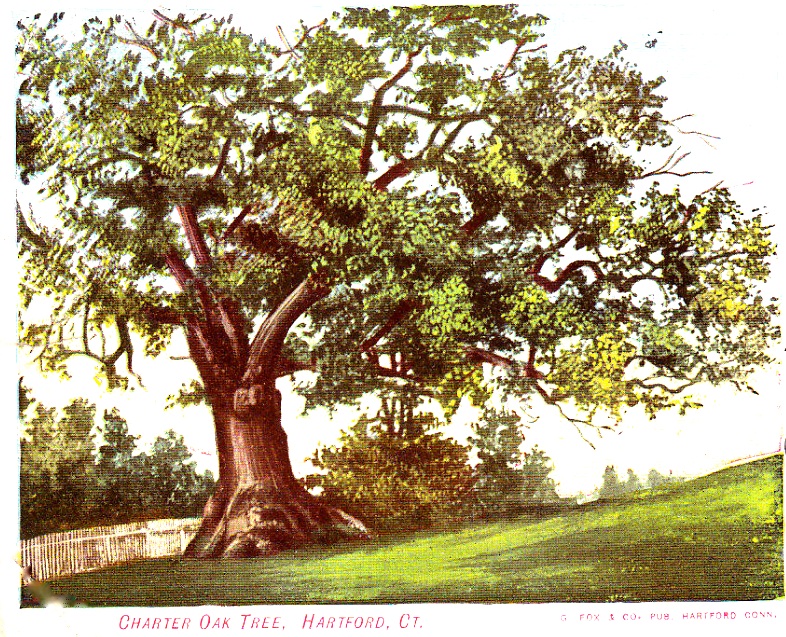
The Charter Oak on a postcard printed by G. Fox & Company, Hartford, Connecticut.
That story of hiding the charter in the hollow of the oak is why its called Charter Oak from this point in time onward – and what became legend has many versions, some more embroidered on than others.
Here's one of the more livelier:

A depiction of hiding the charter in a hollow tree which later became famous for this reason to another culture.
A scene far more stormy than any which had preceded it followed. The governor threatened the colony with the fury of his vengeance, and vowed he would report them to the king as in open rebellion against his authority. The colonists were shrewd and firm, and though some made very sarcastic answers to the governor's charges, they were, in the main, quite respectful. Meanwhile, Captain Wadsworth and his wife's nephew, having the charter, hurried through the crowd, which opened for them to pass and closed behind them. Once in the street they hastened away at a rapid pace.
….
“Stand a little way off, Charles,” commanded the captain. “And watch to see that no one is observing me.”
Then, while Charles stood as sentry, he went to the tree and put the charter in the hollow. Little did the captain or his youthful assistant dream that their simple act would make the old tree historic.
As long as American students shall study the history of their country, will “The Charter Oak” be famous.
That same night Charles Stevens, fearing the wrath of Governor Andros, set out for his home at Salem. The tree in which the document was hidden was ever afterward known as the “Charter Oak.” It remained vigorous, bearing fruit every year until a little after midnight, August, 1856, when it was prostrated by a heavy storm of wind. It stood in a vacant lot on the south side of Charter Street, a few rods from Main Street, in the city of Hartford.
– excerpt from Project Gutenberg,The Witch of Salem by John R. Musick
A 1905 dedication date credits the Society of Colonial Wars in the State of Connecticut 1633-1775 for placing the monument.
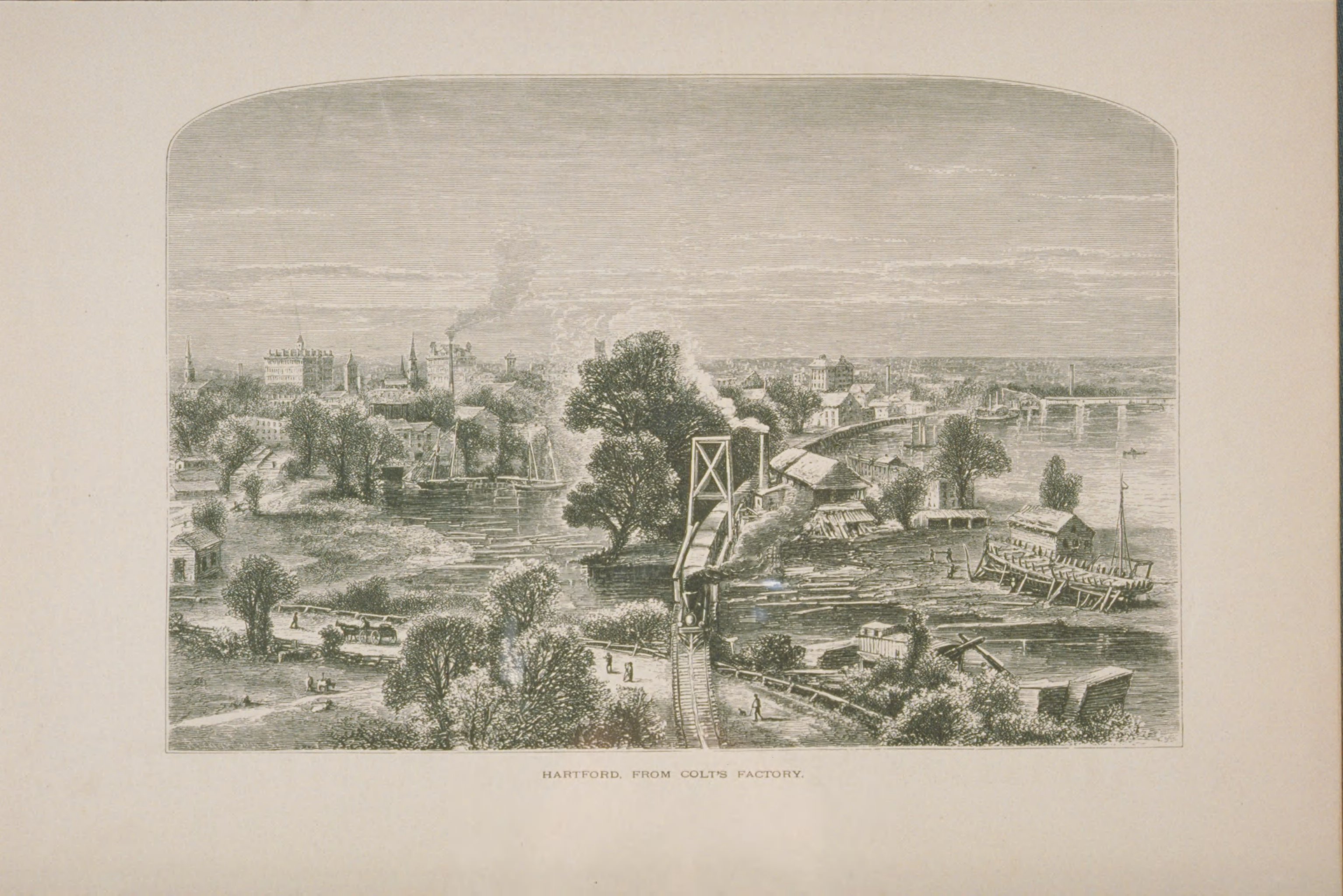
Hartford as seen from Colt's factory, from Connecticut History Illustrated. Note the large tree depicted in this illustration.
In 1614, the explorer Adriaen Block sailing up the great river – that as yet had no name for European people – saw a huge tree and wrote of it in his logbook.
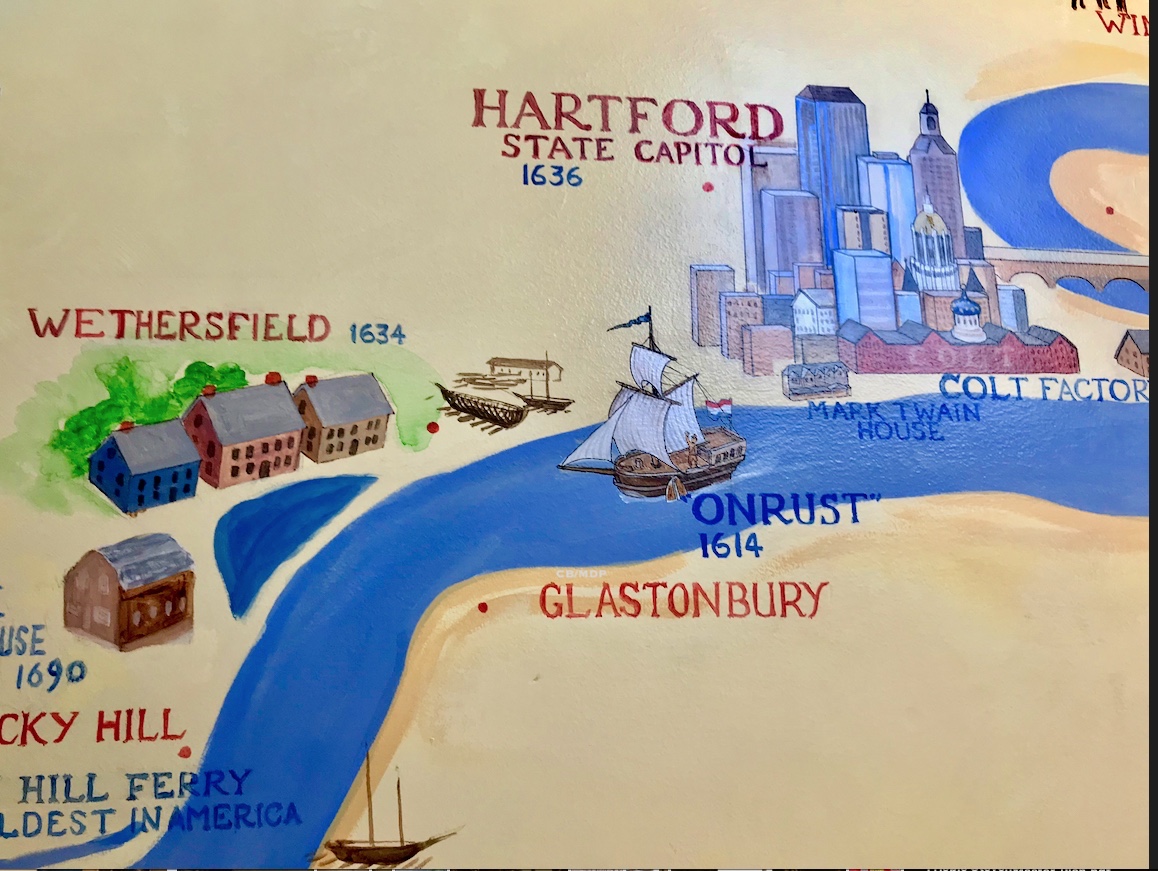
Hello. The Onrust (and Adriaen Block) in the Connecticut River, from a multi-storied mural at the Connecticut River Museum in Essex.
The land – and tree by default – was later owned by Stephen Wyllys. He is the man visited by Native American (see above) who spoke for sparing the oak.
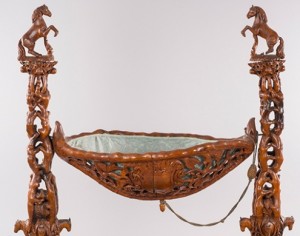
The Colt cradle, designed by Isaac W. Stuart, carved by John H. Most, Hartford; image Wadsworth Atheneum Museum of Art.
Samuel Colt, innovator and founder of Colt's Patent Fire-Arms Manufacturing Company, knew and revered the tree from his boyhood days and life by the river. When it fell, he had a cradle crafted for his son, Samuel. The spectacular object is part of the Wadsworth Atheneum Museum of Art, part of The Elizabeth Hart Jarvis Colt Collection.
“…these good men of the olden time paddled their own canoes so always do yourself and mark it, Sammy, that I caused your cradle to be made in the shape of a beautiful canoe in order to remind you of this sterling duty. Your father thought a great deal of this duty and he acted it out and once told a great committee of the lofty British Parliament that he ‘paddled his own canoe'- Sammy, remember it!”
Note: Part of this story originally was published Aug. 21, 2015 and a portion returns most every August. In a global pandemic, it helps to page back in time and remember what trials, heartaches, tribulations people have had to face to survive in years past, then assess and look forward. The natural world will not be denied no matter how humans ignore signals and patterns; love of growing creates a bridge between humans and business, knowledge that is timeless about life and how that applies to understanding different sectors. Languages. For resources and events, here is a link to our Resources page. For more to see in Hartford? Visit Riverfront Recapture's park by the Connecticut (long, tidal river) River. Call and ask questions of the Mark Twain House & Museum or the Hartford Public Library. There's also the Wallace Stevens Walk and amazing food to discover. Use common sense for personal safety, or go along with a resident to get acquainted with the city.

